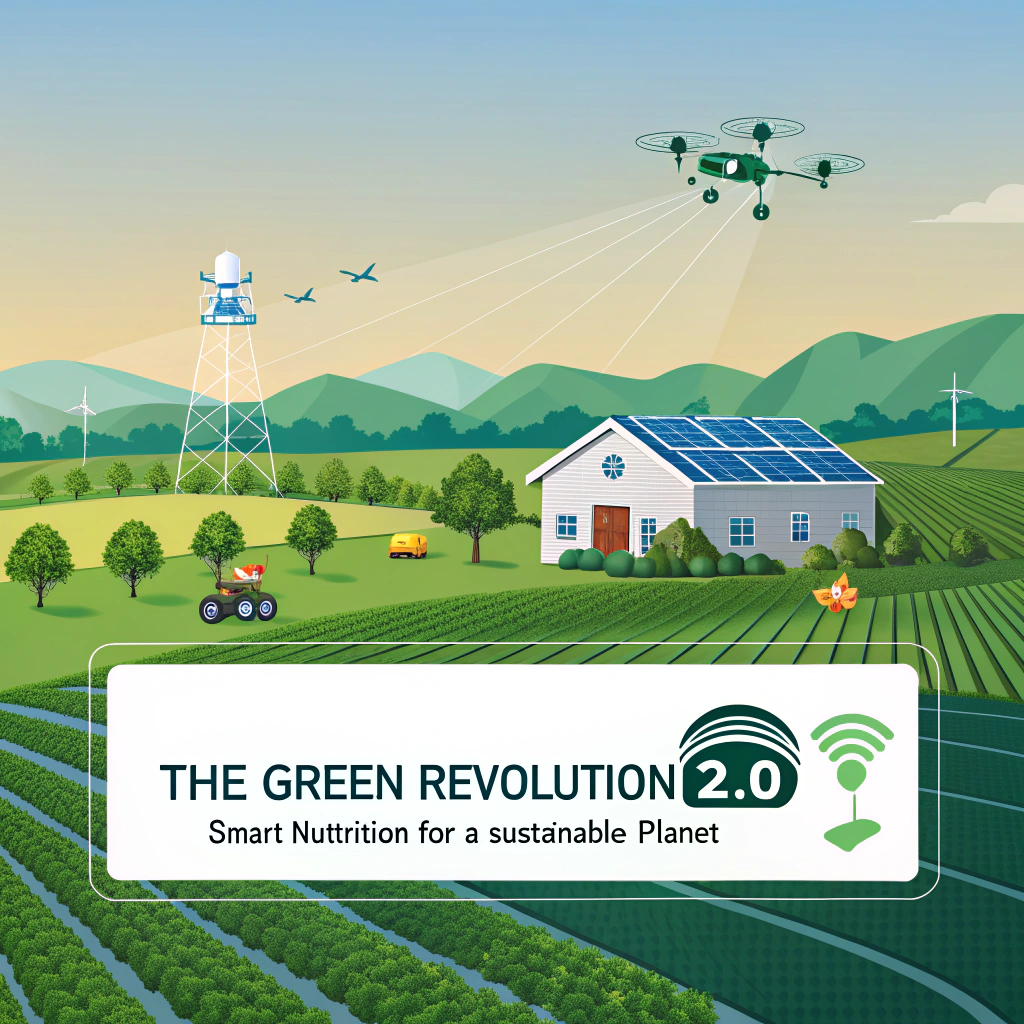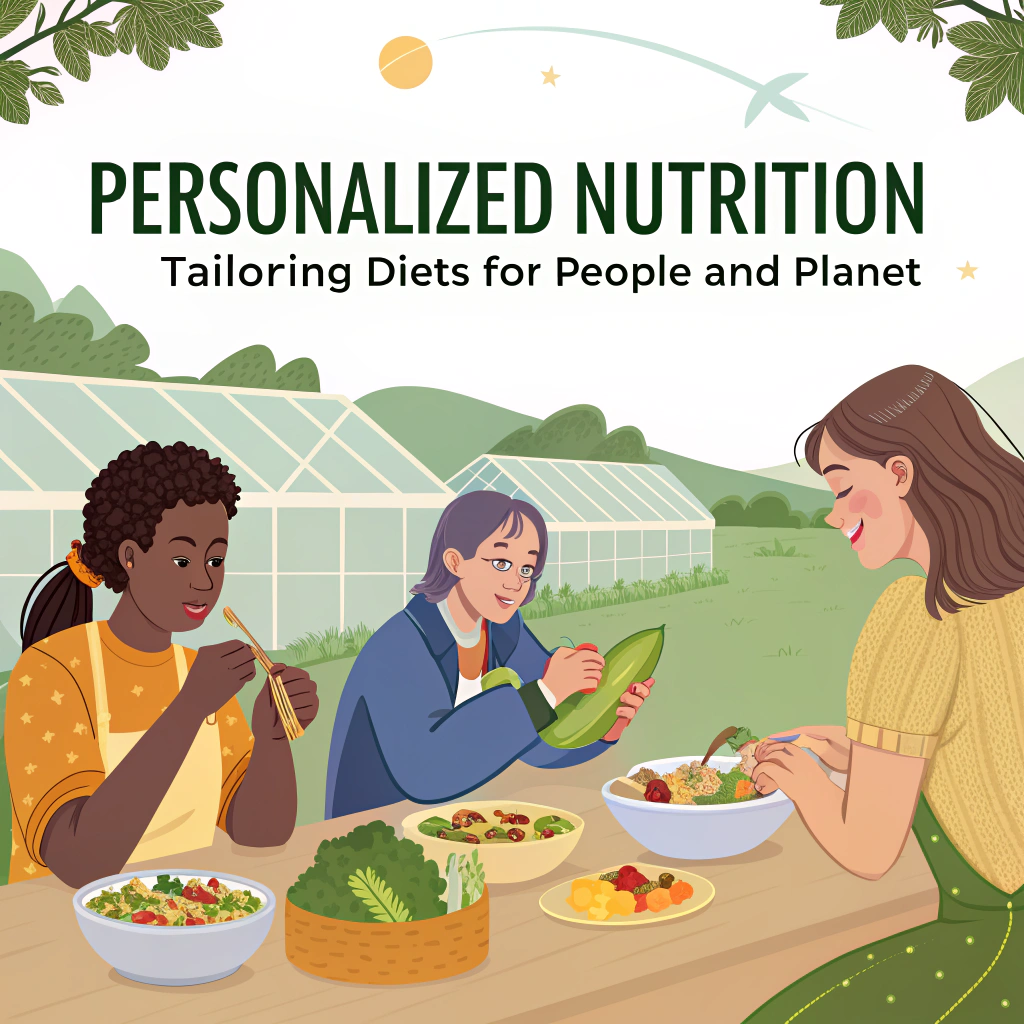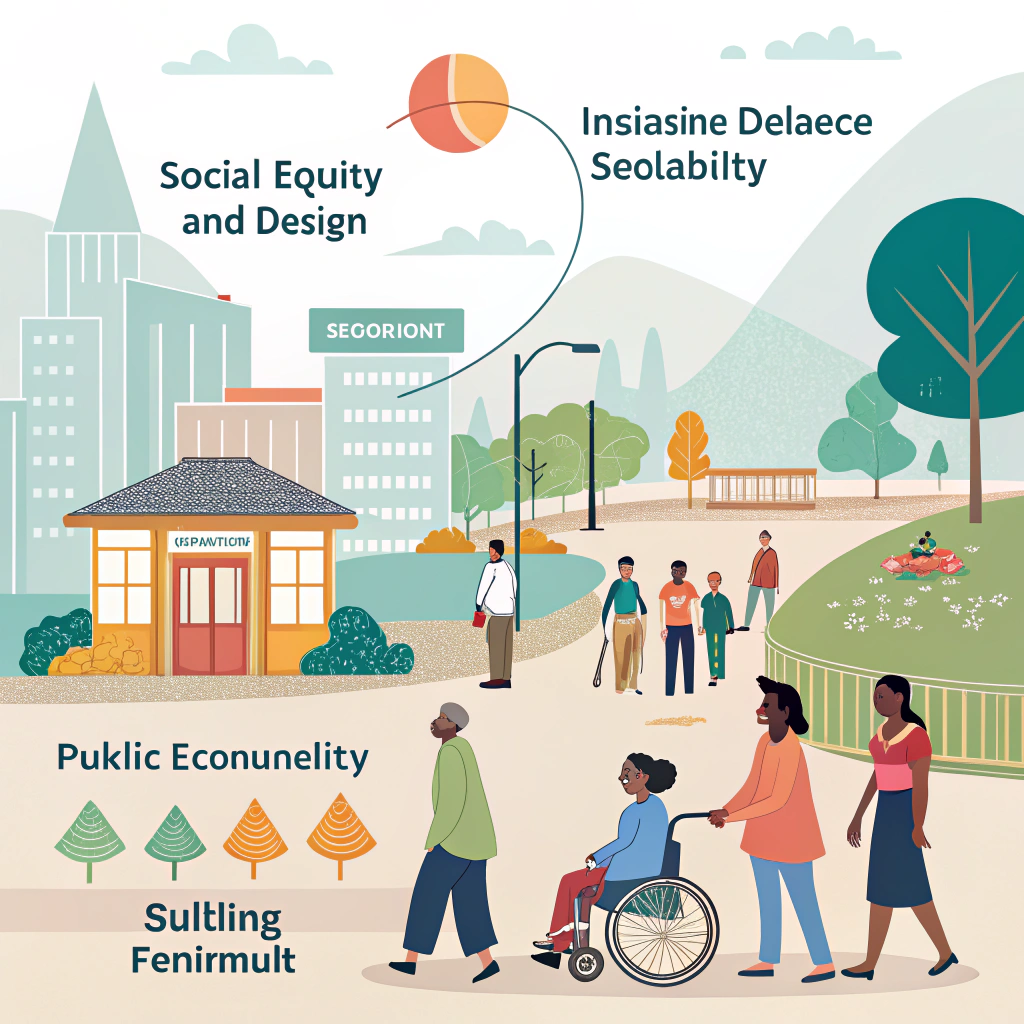The Green Revolution 2.0: Smart Nutrition for a Sustainable Planet
Introduction (200 words)

The original Green Revolution of the mid-20th century transformed global agriculture, averting famine and enabling modern societies to flourish. However, this success came at a cost: monocultures, chemical dependency, soil depletion, biodiversity loss, and a surge in greenhouse gas emissions. Half a century later, as the global population nears 10 billion, the limitations of conventional food systems have become starkly evident.
Enter the Green Revolution 2.0—a transformative movement guided by smart nutrition. This approach doesn’t just strive to increase food output but aims to optimize what we grow, how we grow it, who accesses it, and how it nourishes us sustainably. Smart nutrition harnesses precision agriculture, personalized diets, functional and alternative proteins, waste reduction, and data-driven policy to create a food system that benefits both humanity and the planet.
This article explores how the Green Revolution 2.0 is charting a path toward resilient, equitable, and ecologically sound nourishment—and why this evolution is crucial to survive and thrive in an era defined by climate change.
1. Why a Green Revolution 2.0?
A. Environmental Urgency
Agriculture today accounts for nearly 30% of global greenhouse gas emissions. Livestock alone contributes 14.5% through methane and deforestation. Vast tracts of fertile land, once the lungs of our planet, have been converted to crop fields or grazing pasture. Freshwater reserves are under pressure, with agriculture consuming 70% of global freshwater. The soil beneath our feet—where nutrient cycles and food security begin—is eroding at a rate that demands urgent attention.
B. Nutritional Crisis
While the world no longer grapples with widespread starvation, micronutrient deficiencies persist. Over 2 billion people suffer from anemia, vitamin A deficiency, or iodine deficiency. Simultaneously, overnutrition has become an epidemic: obesity and diet-related chronic illnesses such as diabetes and heart disease now dominate public health concerns.
C. Feeding 10 Billion Sustainably
To feed 10 billion hungry—and often unhealthy—people while keeping climate goals intact, we cannot rely on outdated farming practices. The question is not just how much food we produce—it’s what kind and with what ecological footprint. That is the core mission of the Green Revolution 2.0: produce more nutrition per acre, with less environmental cost, and wider accessibility.
2. What Is Smart Nutrition?
At its essence, smart nutrition means optimizing food systems with precision, intelligence, and sustainability built into every stage—from seed to sustenance. It integrates this approach across four key domains:
- Precision agriculture ensures crops receive exactly the nutrients and water they need—no more, no less.
- Personalized nutrition uses genetic, microbial, and metabolic data to craft diets tuned to each individual.
- Alternative proteins reduce reliance on emission-intensive animal farming by substituting plant-based, cultivated, or fermentation-derived proteins.
- Circular food systems turn waste into resources, ensuring nothing edible or nutritious goes to landfill.
Smart nutrition is interdisciplinary—melding biotechnology, agri-tech, digital sensing, AI, bioengineering, and behavioral science. It requires rethinking not just food production but consumption and policy in real time, with accountability that spans individual plates to planetary boundaries.
3. Precision Agriculture: Farming Smarter
A. Sensor Networks and Drones
Sensors buried in soil monitor moisture, nutrient levels, and microbial activity. Drones carry multispectral cameras to assess plant health, detecting stress from pests or disease before yield loss occurs. This real-time intelligence allows farmers to apply inputs precisely—reducing fertilizer use by up to 40% while increasing crop yields.
B. Automation & Robotics
Autonomous tractors and robotic harvesters equipped with AI can optimize planting depth, spacing, and harvest timing—achieving consistent quality while reducing labor needs and human error. Small robots patrol fields at night, removing weeds mechanically or applying micro-doses of biological pesticides—reshaping farming to be labor-efficient and chemically lean.
C. Climate-Resilient Crop Breeding
Smart breeding techniques, including CRISPR and genomic selection, allow scientists to develop crops that tolerate drought, pests, or salinity. Varieties such as flood-resistant rice or heat-tolerant maize are turning previously unfarmable land into productive fields—expanding our capacity to feed vulnerable regions.
D. Vertical & Indoor Farming
Urban and indoor vertical farms—like those from AeroFarms or Infarm—use hydroponics and LED lighting to grow leafy greens and herbs using 90% less water and no pesticides. These farms can thrive year-round, close to consumers, reducing transport emissions and eliminating food deserts in cities.
Precision agriculture is the backbone of sustainable intensification. By growing smarter—not just more—we protect ecosystems while feeding more people.
4. Personalized Nutrition: Tailoring Diets for People and Planet

A. DNA, Microbiome & Biomarkers
Personalized nutrition platforms analyze DNA for genetic predispositions, profile the gut microbiome’s ability to metabolize foods, and monitor biomarkers like glucose or cholesterol. For example, ZOE and Viome match food recommendations to your unique biology, not generic dietary guidelines.
B. Continuous Feedback Loops
Wearables like glucose monitors, smart watches, and even smart utensils track how our bodies respond in real time to meals. AI systems interpret that data, suggesting tweaks: eat more fiber-rich foods after seeing blood sugar spikes, or balance macros when sleep and stress increase inflammation.
C. Healthy Diets, Lower Emissions
Personalized nutrition systems are not just about health—they can incorporate environmental metrics. Your meal plan could prioritize low-carbon plant proteins or sustainably farmed fish, aligning personal well-being with planetary well-being.
D. Population-Scale Applications
Imagine school lunch programs tailored not only for taste and affordability but optimized for micronutrient content and minimal ecological impact. Hospitals could prescribe healing diets based on real-time patient data. Workplace cafeterias could offer bespoke menus with ecological footnotes—promoting public health and planetary health in every bite.
Smart nutrition brings not just individualized wellness but scalable dietary intelligence that aligns human health with the health of the planet.
5. Alternative Proteins: Rethinking Protein
A. Plant-Based Proteins
Brands like Beyond Meat and Impossible Foods have made major strides replicating the taste and texture of meat using peas, soy, and structured fats. These alternatives emit over 90% fewer greenhouse gases and consume far less water and land than conventional meat—crucial for reducing agri-carbon emissions.
B. Cultivated Meat
Made by growing animal cells in bioreactors, cultivated meat offers meat-identical nutrition and taste—without slaughter or the environmental cost of livestock. Companies like Upside Foods, Eat Just, and Aleph Farms are scaling up production, and regulatory approvals are opening markets in Singapore and the U.S.
C. Fermentation-Derived Proteins
Precision fermentation uses microbes to produce animal proteins like whey or casein. Perfect Day’s cow-free milk proteins and Clara Foods’ egg whites offer dairy-free alternatives with minimal emissions and no animal exploitation.
D. Hybrid Approaches
Early versions of meat alternatives mix plant-based proteins with cultivated fats or fermentation-derived textures—blending taste, economy, and sustainability in one bite.
Alternative proteins are perhaps the most visible symbol of Green Revolution 2.0. They promise to decarbonize diets, curb deforestation, and reduce antibiotic use—while still satisfying cultural expectations for meat.
6. Functional Foods & Biofortification
A. Functional Foods
Commonly available functional foods now include probiotic yogurts, omega-3-enriched eggs, and teas blended with adaptogens. In the future, fortified foods—with added vitamins, fiber, or plant sterols—could be personalized using modular, on-demand kitchen appliances.
B. Biofortified Crops
Bioengineered staples like Golden Rice (vitamin A), iron-fortified beans, and improved sweet potatoes are combating hunger and disease in low-income countries. These nutrient-dense crops reach remote communities without needing supplements or dietary shifts.
Functional foods and biofortification target both public health and food justice by delivering nutrition that adapts to cultural preferences, disease burdens, and ecological conditions.
7. Reducing Food Waste & Enabling Circularity
A. Smart Storage & Packaging
Sensors monitor ethylene, temperature, and humidity inside packages—controlling ripening and extending shelf life. Blockchain-enabled QR codes allow consumers to trace product origins and freshness, rebuilding trust in food quality.
B. AI Supply Chain Optimization
Machine-learning systems predict demand to reduce overproduction. Food systems are becoming agile, adjusting routes and batch sizes dynamically to minimize loss and surplus.
C. Upcycling & Value Recovery
Hotels and breweries are converting spent grain into flours, probiotic drinks, or biodegradable packaging. Ugly fruits and vegetables are turned into juices or powders—minimizing waste at source and finding value in every crop.
Cutting food waste in half could reduce food CO₂ emissions by over 130 gigatons by 2050—enough to meet the Paris climate goals.
8. Data-Driven Policy & Global Collaboration
A. Evidence-Informed Governance
Agricultural and dietary policies will increasingly rely on satellite, sensor, and genomics data—shaping incentives for regenerative farming, carbon-friendly diets, and equitable nutrition access.
B. Public–Private Partnerships
From community vertical farms to rural biofortification programs, partnerships among governments, NGOs, and private enterprise are building pilots well-suited for scale while maintaining local control.
C. Global Standards & Targeted Financing
Profit incentives, carbon pricing, and impact investing can accelerate adoption of smart-nutrition technologies. Developing countries receive tailored support to integrate sustainable food—front and center—in their development strategies.
Smart policy ensures these technologies are tools for global justice and resilience, not just markets.
9. Social Equity & Inclusive Design

Smart nutrition must prioritize inclusion:
- Subsidies should focus on nutrient-rich foods over calorie-dense junk.
- Community programs can provide accessible testing for microbiome or metabolic health in underserved areas.
- Digital literacy must be supported so personalized diet apps don’t leave behind digitally disconnected populations.
- Cultural adaptation is critical—recipes should reflect local tastes and values while being nutritionally sound.
Closing the gap between the Global North and Global South requires democratizing access and ensuring that smart nutrition uplifts all communities.
Conclusion
The dawn of the Green Revolution 2.0 marks the beginning of a new era—where food production doubles as a tool for healing our planet and ourselves. Smart nutrition, powered by data, precision, and equity, redefines success not in bushels or yield, but in health outcomes and ecological boundaries. It balances complexity with simplicity: actionable advice mapped to DNA, soils restored through intelligent inputs, and food production systems redesigned for circularity.
By seeing food through the lens of systems thinking, we unlock solutions that were invisible to earlier generations. The next bite you take could be part of rewilding forests, cooling the climate, or preventing diabetes—without ever leaving your plate. As the world inches closer to feeding 10 billion on a warming planet, the Green Revolution 2.0 offers a path forward—one grounded in innovation, conscience, and collective responsibility.

